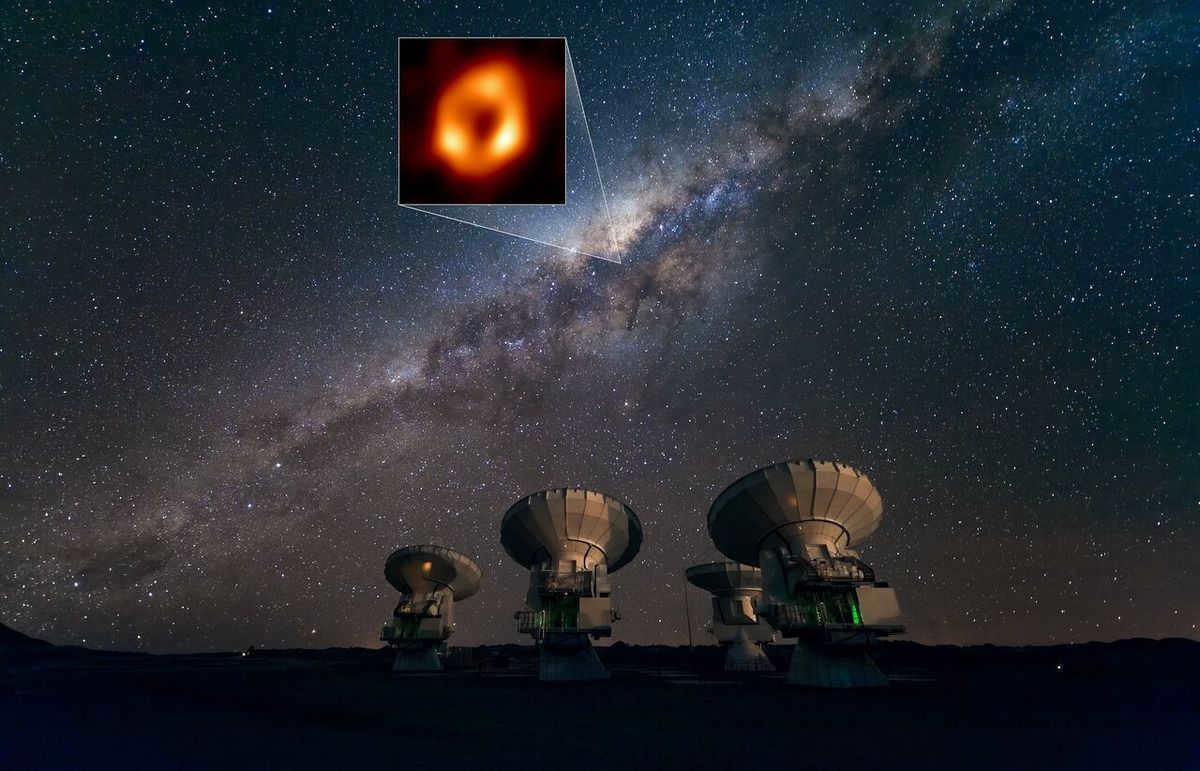
We have all marveled at the photograph showcasing the shadow of a black hole at the heart of our galaxy, but since the 1970s, scientists have been able to observe a detailed image of these supermassive entities on their computers by employing mathematical models.
What led us to anticipate this specific image and how accurate has the anticipation proven to be? Let us delve into the visual structure of black holes!
What is the composition of a black hole?
A singularity at its core
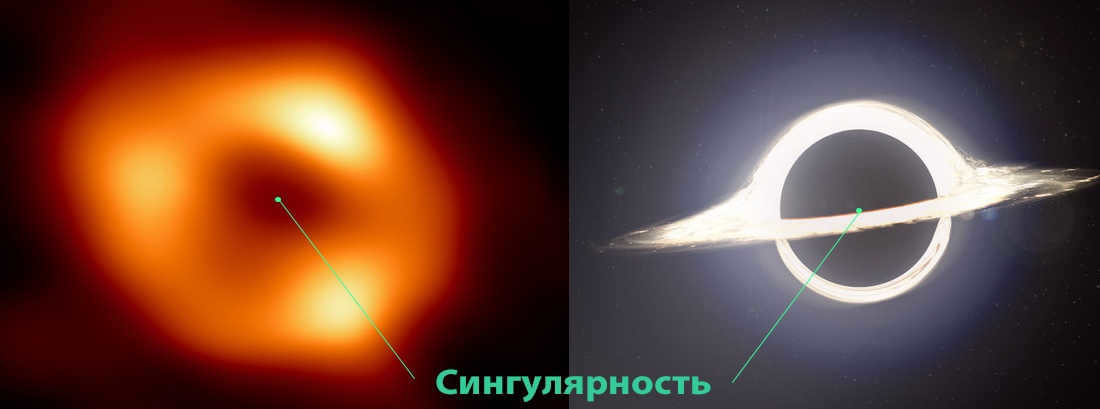
When physicists depict an object, they often mark its center of mass. And when the mass surpasses a certain threshold (around three times that of the sun), it will eventually collapse into a single point.
Illustrating a singularity in this manner is highly convenient – the center of mass becomes the entire object.
Everything that occurs around the singularity serves as a remarkable natural experiment, with every aspect accurately anticipated by the theory of relativity. Explaining past experiences is relatively simple, but predicting the outcome of future experiments is the true brilliance of physics!
Event horizon
is a term used in astrophysics to describe the boundary of a black hole, beyond which no light or other form of radiation can escape. It marks the point of no return, where the gravitational pull is so strong that anything that crosses it is inevitably pulled into the black hole’s singularity. The event horizon is a fascinating and mysterious concept that has captured the imagination of scientists and the general public alike. It is a boundary that separates the known from the unknown, and represents the extreme limits of our understanding of the universe.
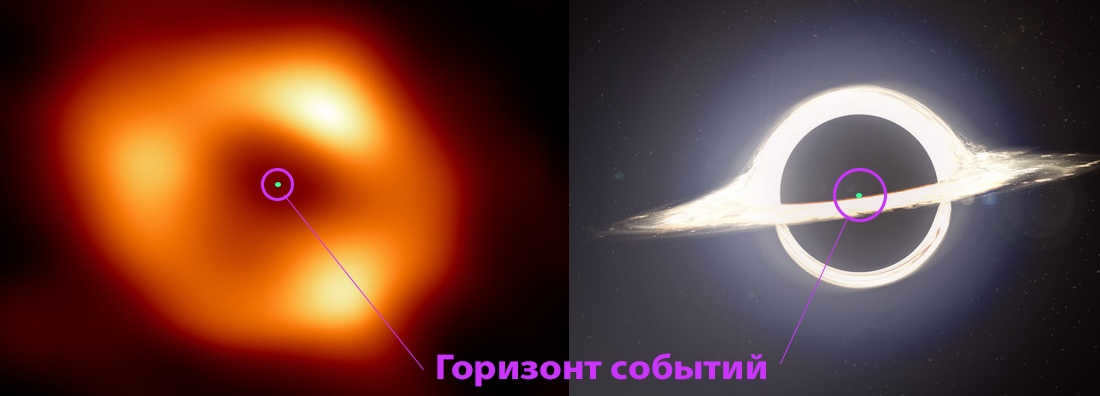
If the singularity did not exist in nature, scientists would have had to create it! However, similar to many fascinating locations in the universe, the singularity remains hidden behind the protective event horizon.
When observed against the backdrop of the sky, the event horizon would appear as a perfectly round black disk if the black hole is static, or slightly distorted if it is rotating.
Due to the powerful gravitational lensing effect, naked black holes would leave distinct marks on the field of view of telescopes: black dots with distortions at the edges.
However, the sizes of event horizons are minuscule compared to the distances between cosmic objects, making it currently impossible to directly view a lone black hole without any surrounding gas using existing methods.
Accretion disk
An accretion disk is a structure formed by the gravitational pull of a central mass, such as a black hole or a star, that causes matter to orbit around it. The matter in the disk gradually spirals inward due to friction and other forces, eventually falling into the central mass. This process releases a tremendous amount of energy in the form of radiation, making accretion disks some of the brightest objects in the universe.
Accretion disks are found in a variety of astronomical objects, including active galactic nuclei, X-ray binaries, and young stars. They play a crucial role in the growth and evolution of these objects by providing a mechanism for mass transfer and angular momentum transport.
The study of accretion disks has provided valuable insights into various astrophysical phenomena, such as the formation of jets and outflows, the production of high-energy radiation, and the formation of planets. Observations and theoretical models of accretion disks continue to improve our understanding of the universe and its many wonders.
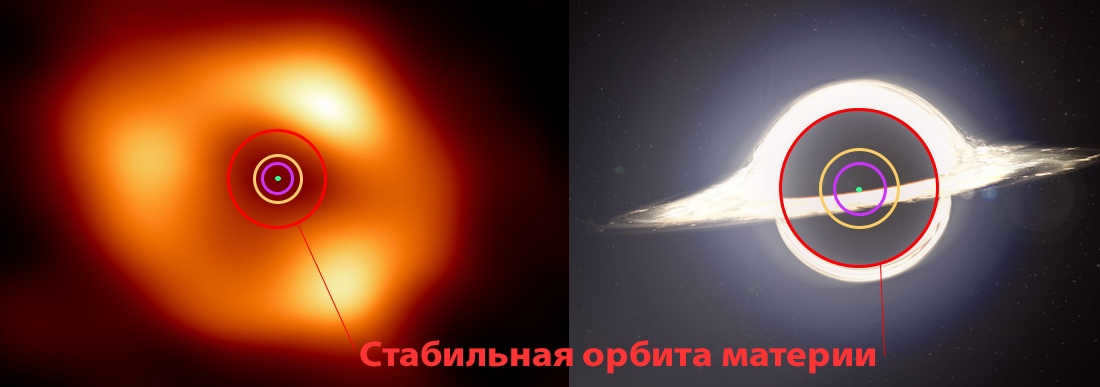
From a distance of approximately 2.6 times the event horizon, a stable orbit of luminous burning gas commences. The accretion disk enables the visualization of the black hole’s impact in images.
The area within the stable orbit inevitably entraps matter, causing it to plunge into the abyss prior to emitting light. This particular region is referred to as the black hole’s shadow.
When observing the disk from the front, it is logical to perceive a circular shape. However, in Interstellar, our viewpoint of Gargantua was at an angle to the accretion plane.
From this angle, it is expected to observe a radiant ring akin to that of Saturn, but encircling a black silhouette.

The curved path of light from the back portion of the accretion disk, concealed from our view by the event horizon, and the presence of its own stable orbit, below which the likelihood of being observed by a distant observer is relatively low.
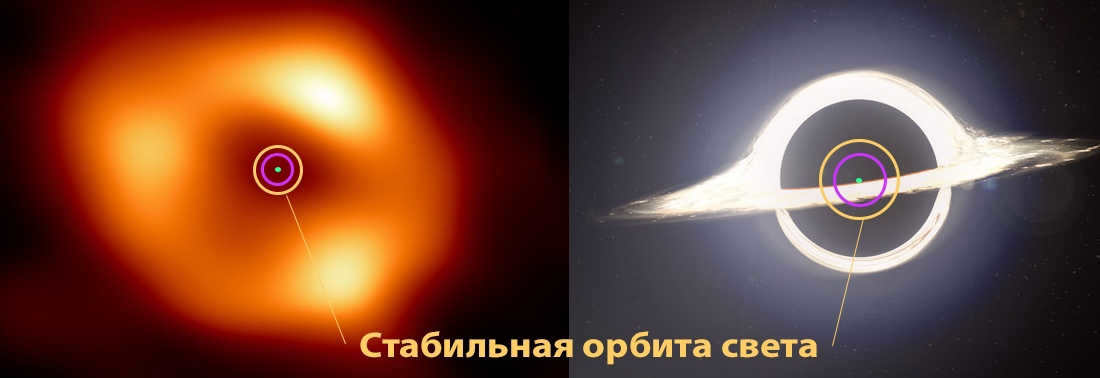
The black hole’s gravitational pull bends the path of light, causing it to curve around the black hole and come to us from a direction that is usually invisible. This phenomenon allows us to observe both the front and back of the accretion disk, creating a primary image and a secondary image in the form of a luminous ring.
Essentially, the radiation emitted by the gas disk can loop around the event horizon multiple times, similar to satellites orbiting around planets. If we were able to venture close to the black hole, we would witness a multitude of secondary images of the accretion disk from various angles and moments in time. It would undoubtedly be one of the most awe-inspiring sights in the entire universe.
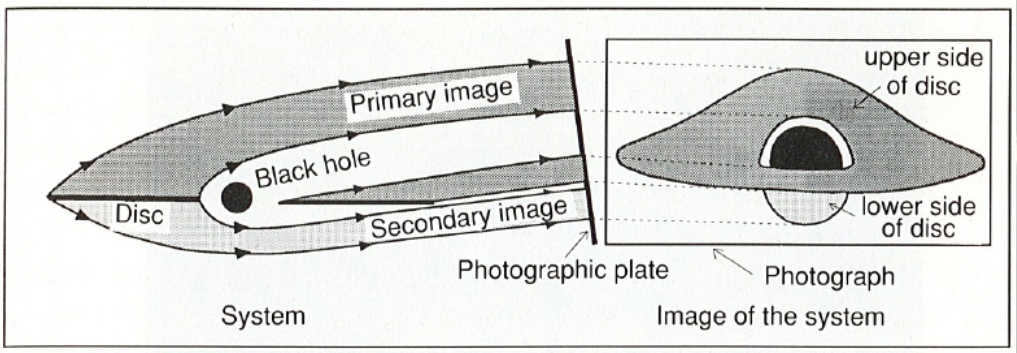
The radiation intensity of the disk solely relies on its temperature, which, in turn, depends solely on the distance to the black hole. Consequently, the intrinsic brightness of the disk cannot be uniform. The highest brightness originates from the inner regions in close proximity to the event horizon, as it is in those areas where the gas reaches its highest temperature.
Moreover, the image perceived by a distant observer will experience a shift in both frequency and intensity due to two distinct effects:
– The Einstein effect, in which the gravitational field causes a reduction in both frequency and intensity;
– The phenomenon of Doppler effect causes the light emitted by a gas that is approaching us to appear brighter and bluer, while the light emitted by a gas that is moving away from us appears darker and redder.
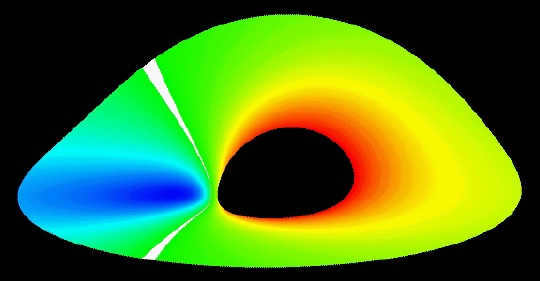
The movement of the particles within the accretion disk is assumed to be below the speed of light, resulting in a significant manifestation of the Doppler effect. Consequently, an asymmetrical image should be observable, serving as the primary indication of a black hole within the image. The substantial, though not singular, mass of dark matter should not cause the gas to rotate at speeds close to that of light.

The hand simulation by Lumine bears a remarkable resemblance to Kip Thorne’s interstellar model, although it does not closely resemble the actual image of Sagittarius A*.

It is important to note that the models depict radiation emitted across a broad range of wavelengths. When viewed up close by a traveler on a galactic scale, this is likely how a black hole would appear. However, since we are observing from a considerable distance, we were only able to capture a small portion of the spectrum – specifically, millimeter radio waves – in order to take the photograph. The majority of the accretion disk radiation’s wavelengths were stretched to millimeter size due to the Doppler and Einstein effects.
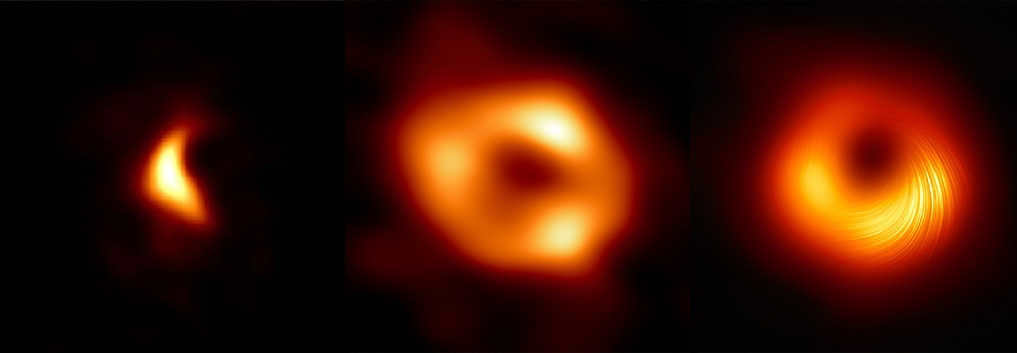

By filtering out the excess spectra from the radiation captured in 2017, a model with a crescent shape was obtained, which closely resembles the actual image.
Is the same phenomenon observable in reality?
In essence, the answer is no. Observing the visible area surrounding a black hole is comparable to observing the sun without any filters or coronagraphs – the naked eye won’t perceive anything.
The colors depicted in photographs and simulations illustrate physical phenomena, but they do not represent a realistic visual image.
A cloud of gas is not transparent enough for our eyes to directly perceive anything other than a bright spot.
Furthermore, the conditions for humans near such an object are far from ideal.
In general, it is fortunate that we can only experience the magnificence and peril of black holes through the power of our imagination.
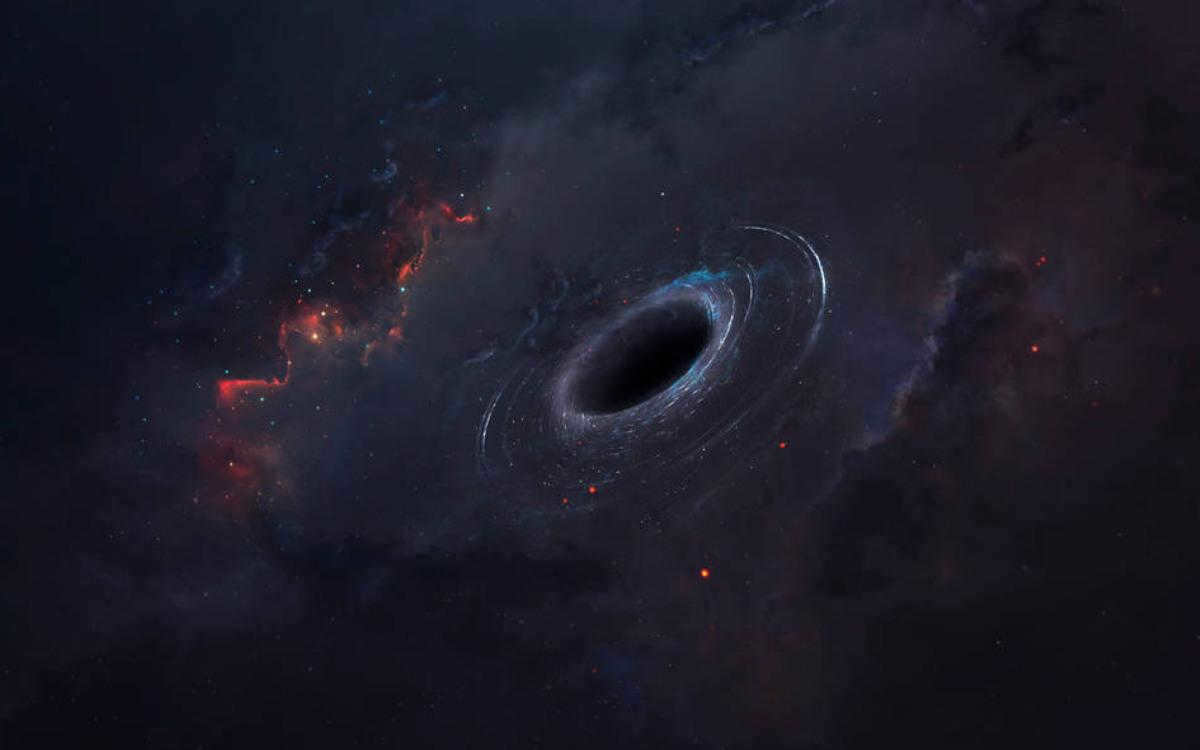
About the expert: Sergey Popov, Doctor of Physical and Mathematical Sciences, Professor of the Russian Academy of Sciences.
Astronomy is a fascinating field as it presents unique challenges in studying objects that cannot be directly experimented on. However, advancements in technology, such as new telescopes and astronomical satellites, have provided us with a wealth of data on various celestial bodies, including the enigmatic black holes. These advancements have allowed us to gain a deeper understanding of their structure, formation, and behavior within the vast expanse of the universe.
A black hole is a space region characterized by an extremely powerful gravitational force, which attracts and absorbs all nearby objects, including light. Sergey Popov, a professor at the Russian Academy of Sciences, clarifies that black holes do not have a universally accepted definition, and the one provided here is merely one possibility. If you inquire with various scientists, such as astrophysicists and physicists, they will offer different perspectives on the matter. While encyclopedic dictionaries may offer precise definitions and concrete answers, there is no singularly correct formulation.
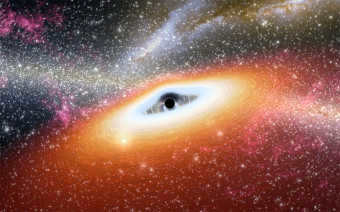
The Classification of Black Holes
There are four distinct types of black holes. All objects have the ability to distort space and time in their vicinity. The level of distortion is directly related to the compactness of the object. Compactness is not solely determined by size, but also by mass. A small object with a large mass can also be considered compact. Black holes are an extreme example of compactness. By compressing any object, such as a gas cloud or a neutron star, we can eventually create a black hole. This is where things drastically change. Once an object becomes a black hole, information from the inside cannot escape to the outside. This is why black holes are often regarded as mysterious rather than simply interesting. The inner workings of black holes remain largely unknown to us.
There are two ways to approach the study of black holes. The first approach is more focused on the physical aspects, where we discuss the characteristics and internal properties of black holes. However, at this point, our understanding is limited to theoretical research. The second approach is more astrophysical in nature. In the field of astrophysics, there are four main categories of black holes.
One of the most well-known types is the supermassive black hole. Every large galaxy has a central black hole, and these can range in mass from a few thousand solar masses to tens of billions. In fact, our own galaxy contains such a black hole at its center.
Sometimes there is a distinct form of black hole, a distinct form of black hole with an intermediate mass – something that exists between stars and supermassive black holes. The origins of these objects are still unknown. It is possible that several massive stars merged in a dense cluster and briefly formed a star with a mass of, for example, a thousand times that of the Sun. However, this star did not undergo a rebound.
Additionally, there are primary black holes that are believed to form in the early Universe. The fascinating aspect of these primary black holes is that they appear before anything else – before stars and galaxies. Moreover, they can have a wide range of masses, varying from large to microscopic. These objects possess various distinctive characteristics. They are eagerly sought after for discovery, but thus far, all attempts have been unsuccessful.
Thus, in actuality we are confronting supermassive black holes and black holes with the mass of a star, and we also possess several promising contenders for black holes with intermediate masses.
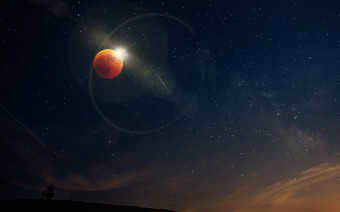
Exploring the Surroundings of a Black Hole
Signals cannot escape the interior of a black hole, making it impossible to directly observe the black hole itself. Instead, scientists focus on studying the processes occurring in the vicinity of black holes, whether they are supermassive or stellar-mass. The primary method of investigation involves observing the matter that becomes heated in the vicinity of a black hole.
Stars, particularly massive ones, have a tendency to be born in pairs. Frequently, there arises a circumstance in which material transfers from one star to another. This second entity may be a compact object: a white dwarf, a neutron star, or a black hole. Once again, a disk is created and its radiation becomes apparent. This is how the initial notable black hole candidates were identified, such as the renowned Swan X-1 source. However, in the majority of binary systems, there exists no such material transfer. It turns out that astronomers tend to look in the obvious places – where it is easier to find. We observe those entities that reveal their presence through intense radiation.
Observing Binary Systems of Stars and Black Holes
When the concept of black holes first emerged, it was a straightforward notion. Imagine a scenario where there are two stars. One of them undergoes a transformation into a black hole. However, we can still observe the other star. So, what happens when these two stars come together and create a binary system? They orbit around a common center of mass. At this point, it becomes crucial to study the movement of the visible star – to obtain its spectrum and detect any shifts in spectral lines, indicating the Doppler effect: whether the star is moving towards or away from us. This rotation around the center of mass in a double system is significant. If it can be demonstrated that the second component is sufficiently massive, with a mass exceeding three times that of the Sun, and is invisible, then it can only be a black hole. This idea was initially proposed in the early 1960s. However, at that time, it was not possible to observe any such objects, and only in recent years have articles begun to emerge where scientists claim to have observed such a system.

Until recently, all potential candidates were ultimately rejected. However, this year, a groundbreaking study was published where individuals claim to have observed such a dormant black hole in a binary system. This discovery holds significant importance as our understanding of which stars give rise to black holes and which stars give rise to neutron stars is still quite limited.
Additionally, it is highly intriguing to determine the velocity at which black holes are formed. This information will provide insight into the process of collapse. This process is incredibly intricate and we are currently attempting to simulate it on computers, but the finer details remain elusive. In fact, there are numerous approaches to modeling it. To identify the most accurate one, we must compare the outcomes with actual data.
Observing a Solitary Black Hole: The Collapse of a System
Not all stars in motion signify the existence of a nearby black hole – the displacement must reach a significant magnitude. Until now, it has been challenging to approach these stars closely. However, the European satellite Gaia, currently in orbit, presents a solution by precisely measuring the positions of stars. This valuable data provides us with statistical insights into black holes and is expected to greatly enhance our comprehension of their origins.
If a binary system collapses and a star explodes, a situation more dire than a black cat in a dark room arises: a solitary black hole traversing through the darkness of space. However, it appears that the general theory of relativity provides a means for us to detect the presence of a black hole. This is made possible through the phenomenon of gravitational lensing. Picture this: we are gazing upon a star, and suddenly its radiance begins to symmetrically intensify across all spectra – this signifies the passage of a massive object between us and the star, distorting the fabric of space-time. The challenge lies in the minuscule probability of such an event occurring. Just like capturing a breathtaking photograph, such as an airplane against the backdrop of the moon, merely pointing your camera towards the sky is unlikely to yield such a stunning shot. However, the likelihood increases if you are situated near an airport and airplanes frequently traverse the area. Similarly, in order to observe the effects of gravitational lensing, it would require an extensive period of observation – akin to capturing the brilliance of an immense number of stars.
There are approximately 400 billion stars within our galaxy, along with several hundred million black holes. After numerous years of careful observations, we have finally discovered potential instances where we can detect the existence of a solitary black hole simply floating through space. These instances occur when the black hole unintentionally magnifies the light emitted by a far-off star, ultimately revealing its presence. This remarkable discovery enables us to accurately calculate the mass of the black hole, a crucial factor in understanding the final stages of stellar evolution.
Neutron stars usually have a mass ranging from one and a half to two times that of the Sun, while black holes typically range from seven to ten times the mass of the Sun. There are only a few objects with masses in between these ranges. However, thanks to the Gaia satellite’s detection of gravitational lensing, a black hole within this mass gap has been identified. This discovery plays a critical role in our comprehension of stellar evolution and brings us closer to unraveling the mystery of which stars ultimately collapse into black holes.
At present, the most unusual astronomical observations involve the quest for bursts of gravitational waves. This offers the most effective means of examining black holes in significant quantities while ensuring precise measurement of their masses. The majority of massive stars are born within double systems. It is conceivable that both stars may transform into black holes and the systems remain intact. Two black holes revolve around a shared center of mass. They gradually lose energy by emitting gravitational waves – this phenomenon can be likened to the complete friction of space’s curvature. Consequently, energy is extracted from the binary system, causing the black holes to draw nearer to one another.
As two black holes come closer to each other, the emission of gravitational waves becomes more intense. Ultimately, the black holes merge, resulting in the release of a significant amount of energy, albeit in a highly unique form – gravitational waves. It was not until the 21st century that installations capable of recording this phenomenon were developed. In September 2015, the LIGO facilities successfully detected a burst of gravitational waves from the merger of two black holes. Since then, there have been a total of 100 observed instances of gravitational-wave bursts.
By making such observations, we can determine another interesting factor – black holes approach each other in an asymmetrical manner. One black hole may have a greater mass than the other, and the direction and velocity of their rotations may not align. As a result, gravitational waves are emitted in an asymmetrical manner as well, carrying away energy and momentum. Since momentum must be conserved, when black holes merge and gravitational waves carry away more momentum in one direction and less in another, the black hole will start to move. It will fly towards the direction where less momentum has been taken away to compensate for the imbalance. This leads to the question: how fast can a black hole move? It turns out, they can move very quickly – at speeds of thousands of kilometers per second. The speed at which a black hole moves depends on the ratio of their masses and the alignment of their rotation axes.
The significance of the gravitational-wave propulsion is highly significant. It was initially devised by physicists in the 1960s, and later on, astrophysicists rediscovered it in the 1990s and realized its potential for actual observation. For instance, the ability to achieve speeds of hundreds of thousands of kilometers per second enables a black hole to escape the confines of its galaxy and traverse through intergalactic space. In other words, intergalactic space is far from being empty; in reality, it is marked by a multitude of black holes. The confirmation of this fact became possible for the first time through the analysis of data collected from the LIGO facilities.
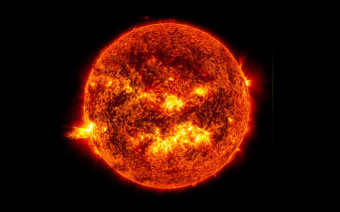
However, advancements in observational instruments have led to increased sensitivity, resulting in a constant stream of new records being set. The discovery of stars in close proximity to black holes continues to push boundaries. Recently, a star was found that completes a revolution around a black hole in just nine and a half years. Even more impressively, scientists have now identified a star that completes a full revolution in a mere four years, setting a new record.
These discoveries are particularly intriguing because they highlight how the effects of the general theory of relativity intensify as objects approach black holes. However, there is a limit to how close a star can get before the immense tidal forces tear it apart. When a star crosses this threshold, an accretion disk forms around the black hole, causing it to become active and consume the surrounding matter.
It is a challenging yet fascinating task to study black holes. The previous year has witnessed a plethora of breakthroughs in this particular domain. To put it succinctly, we have managed to acquire a substantial amount of fresh insights on black holes, including ones that were previously considered highly elusive to observe.
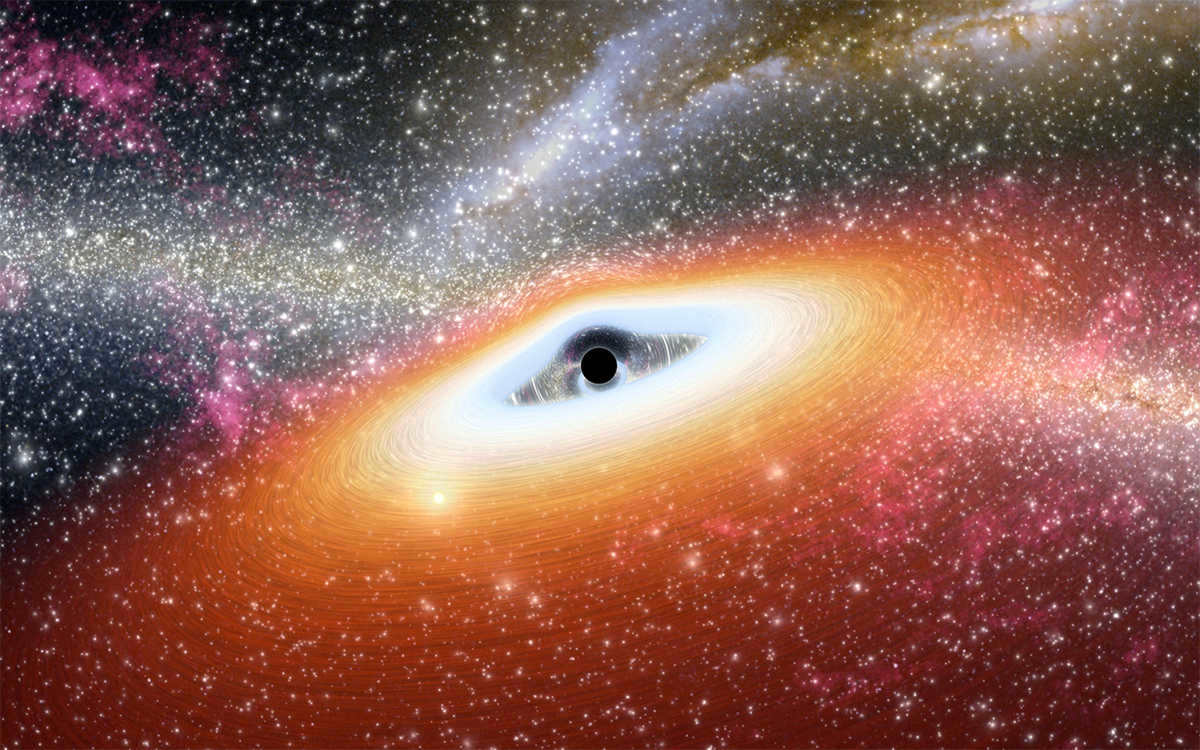
A black hole is an area within space that possesses an incredibly powerful gravitational force, capable of attracting and engulfing everything in its vicinity, including light. According to RAS professor Sergey Popov, black holes lack a precise definition, and the existence of even one such definition is just one possibility. Different scientists, such as astrophysicists and physicists, approach the question from varying perspectives. While encyclopedic dictionaries attempt to consolidate definitions and provide specific answers, there is no universally correct formulation.
Sergei himself defines black holes as extremely compact objects that lack surface properties. These objects have a size that corresponds to the Schwarzschild radius, which is the distance from the center of the object to its event horizon. The event horizon, often referred to as the “point of no return,” marks the boundary of the black hole. Each object has a unique Schwarzschild radius that can be calculated. If any object were to be compressed to this radius, it would transform into a black hole. To put it into perspective, if we were to compress the Sun and turn it into a black hole, its radius would shrink to a mere 3 kilometers, compared to its original size of about 700 thousand kilometers.

The term “black hole” is a cleverly coined name. Just like the Big Bang. The concept of black holes originated in the late 18th century, although they were referred to by different names at the time, such as “frozen stars” or “collapsars”. Eventually, the term “black hole” was suggested by the scientific journalist Ann Ewing.
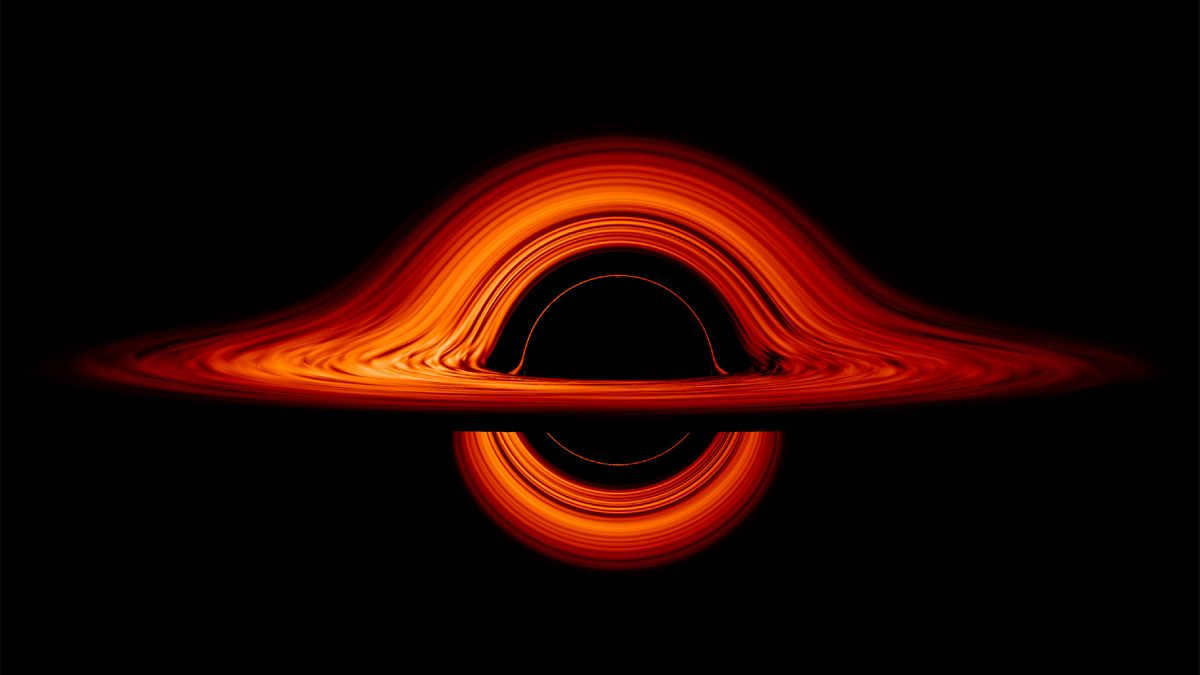
Sergei explains that in the field of science, certain word combinations often become established simply because they are convenient. The term “hole” is used because anything that enters a black hole cannot escape. And the term “black” is used because a black hole does not emit any light or very little light. If we imagine an empty Universe, a space that is completely black, and we place a black hole within it, it would be impossible to see the black hole. It does not stand out in any way against the black background.
The Concept of Black Holes in Relation to Space-Time
Black holes can be defined as a specific region within the fabric of space-time. Sergey Popov clarifies that all contemporary explanations of gravity are based on geometrical theories, which view gravity as a fundamental property of space and time. This implies that space and time are interconnected and can be considered as equivalent quantities.
Since the early 20th century, when Einstein first introduced the theory of relativity, space and time have been united as a single entity. Any object, regardless of its size, has the ability to warp the surrounding space and simultaneously influence the flow of time. Modern measurements have provided evidence of the varying passage of time in different locations. This phenomenon can be experimentally observed and measured.
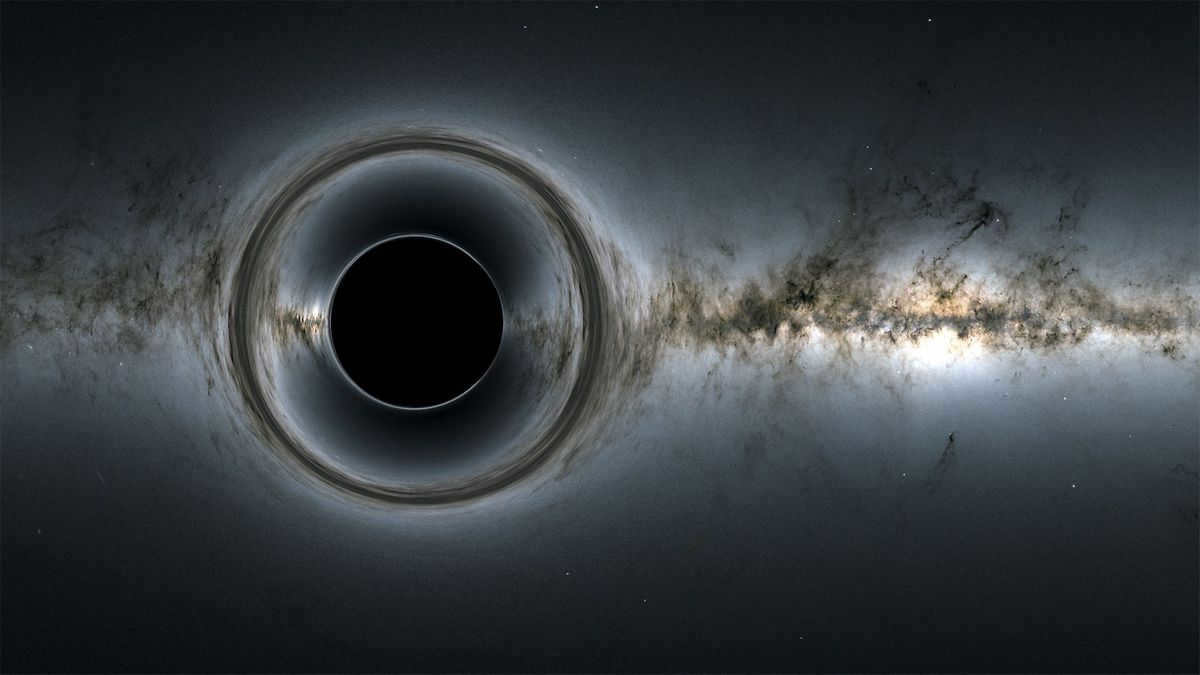
A black hole is an incredibly powerful force that dramatically affects the fabric of space. It occurs when an immense amount of matter or energy becomes concentrated in one location, causing space-time to become warped and forming a distinct region. While we can refer to a black hole as an object, it doesn’t fit our conventional understanding of an object having a surface. Imagine walking through a pitch-black room and encountering a table – you would perceive it as an object with a discernible starting point. However, if you were to enter a black hole under the same conditions, you wouldn’t be able to see its boundaries. This is because a black hole lacks a solid surface, immediately enveloping anyone who enters within its grasp.

Black holes are primarily fascinating due to their extreme nature. They represent the utmost distortion of space-time, and in their vicinity, numerous effects become significantly more pronounced. This gives rise to fundamentally novel physical phenomena.
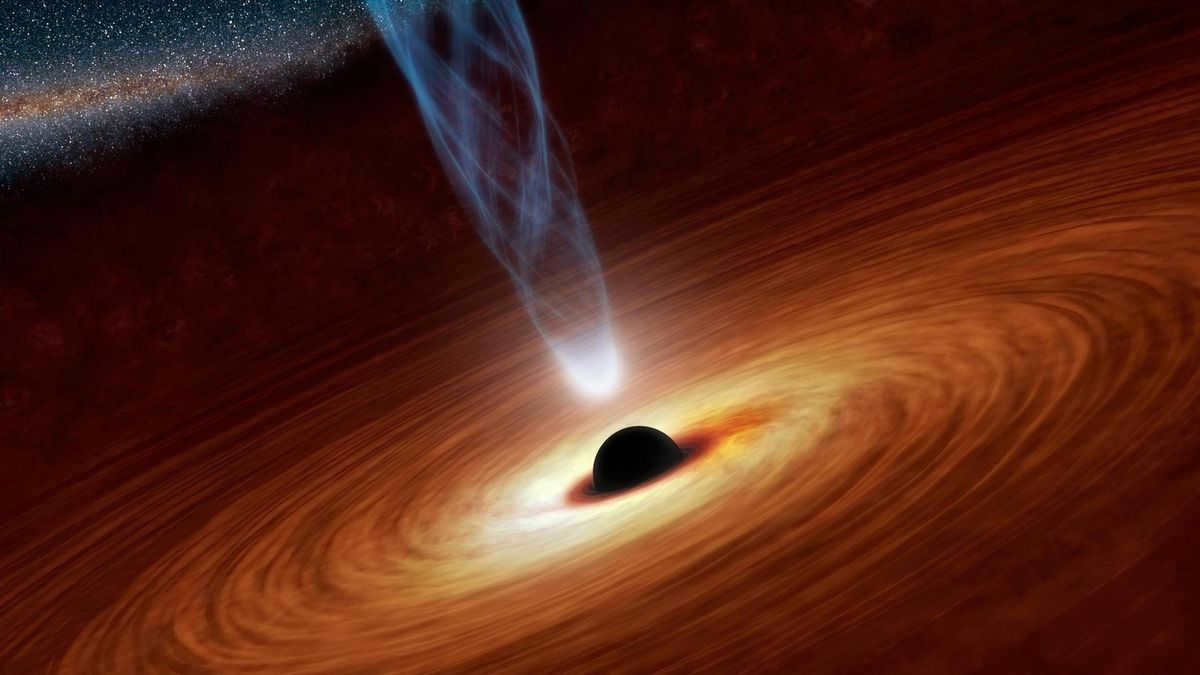
According to Sergei, the study of matter’s behavior near black holes is an incredibly fascinating aspect of the theory of gravity, as it aims to understand these extraordinary celestial objects.
Methods of Identifying Black Holes
When massive stars reach the end of their lifetimes, they have the potential to transform into black holes. During the initial exploration of these enigmatic entities, scientists pondered how to detect their existence. The initial proposition was that stars, particularly those of significant mass, often form in pairs. One star within this pair would evolve into a black hole, rendering it invisible to the naked eye. However, it would still exert gravitational influence on its surrounding environment. By carefully observing the orbital patterns of a neighboring star, scientists could employ complex calculations to estimate the black hole’s mass and thereby confirm its presence.
Sergey Popov claims that this was the original method suggested for the search, with scientists attempting to find them using this approach since the 1960s. However, their efforts have yielded no results. Recently, potential black hole candidates have emerged, but scientists remain uncertain if they are truly associated with ordinary stars.
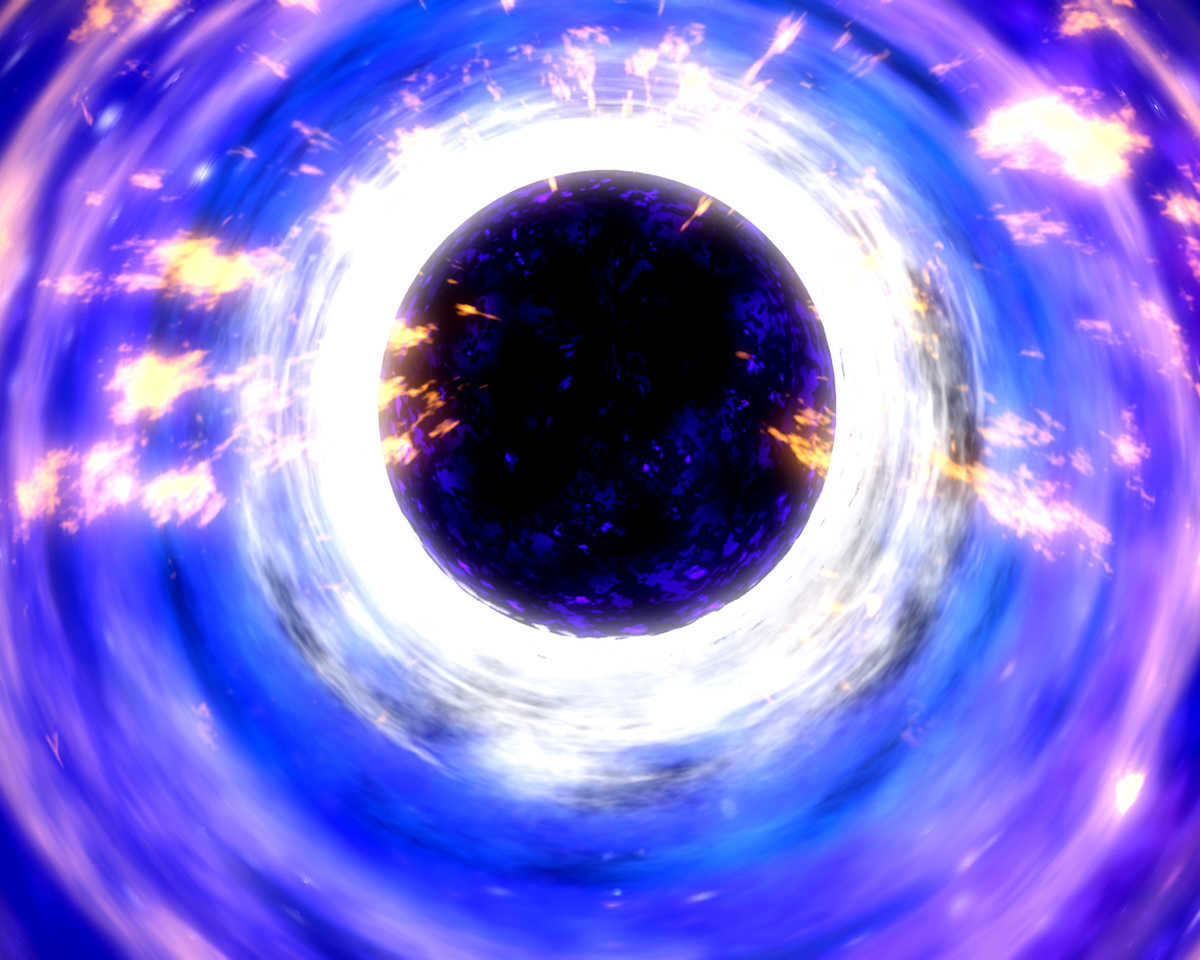
If we consider the black hole once again, which is in close proximity to the star, it is possible for matter from the ordinary star to flow into the black hole. The black hole will exert its gravitational pull and absorb this material. If we envision the scenario where two rocks are simultaneously thrown into the black hole, they could potentially collide beyond the horizon at a speed close to that of light. This collision would result in the release of a significant amount of energy, which would be observable.
However, stars do not possess rocks; they consist of gas. When different layers of gas come into contact with each other, they become heated to temperatures reaching millions of degrees, and this heat can be detected. Utilizing this approach, the first black holes were discovered in the late 1960s and early 1970s, when the initial X-ray detectors were launched into space.
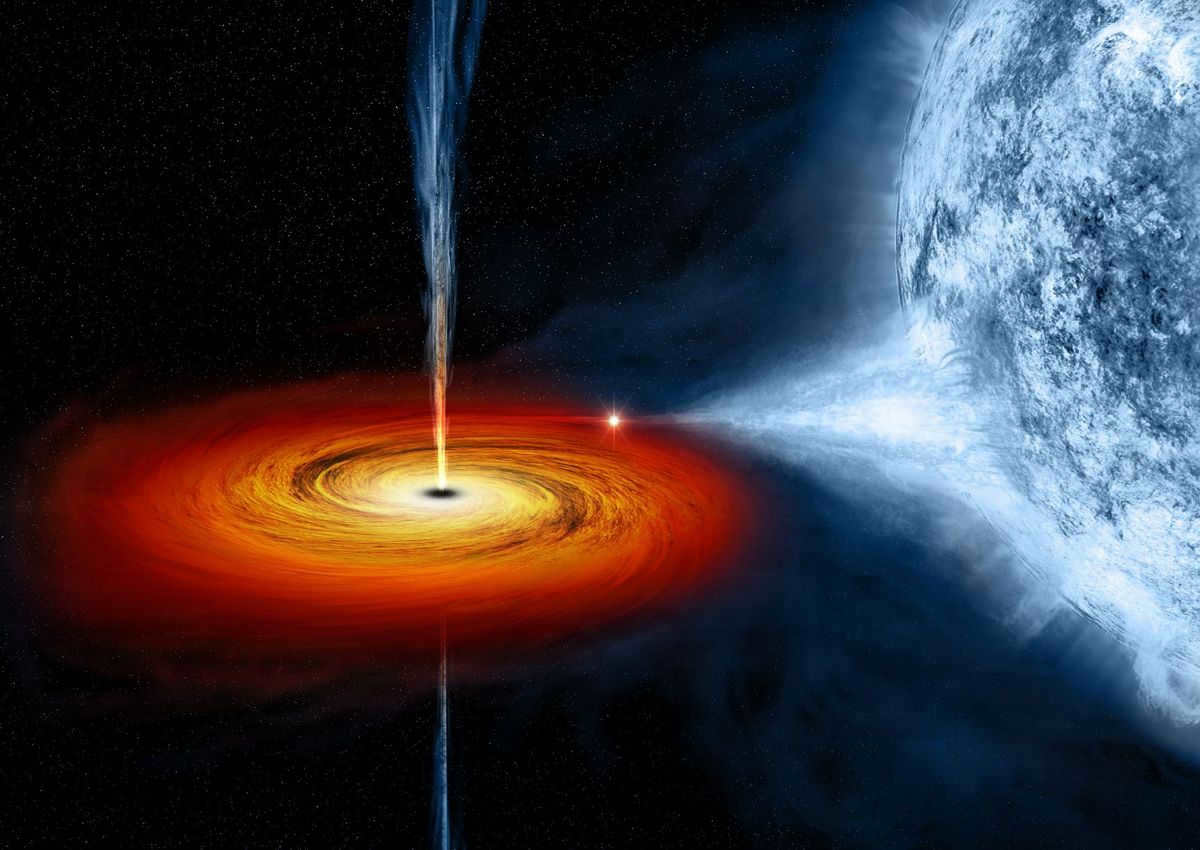
In the early 1960s, it became evident that there exist luminous celestial objects known as quasars. These objects are often referred to as “star-like radio sources.” Quasars are essentially active galactic nuclei in their early developmental stages, with supermassive black holes situated at their cores. Remarkably, quasars can be detected even at incredibly vast distances. Through the examination of quasars, scientists have come to understand that these phenomena are small sources located at the heart of remote galaxies, yet they emit an immense amount of energy. According to Popov, the discovery of a quasar invariably leads to the identification of a supermassive black hole. This method stands as the most effective means of uncovering black holes in the present era.
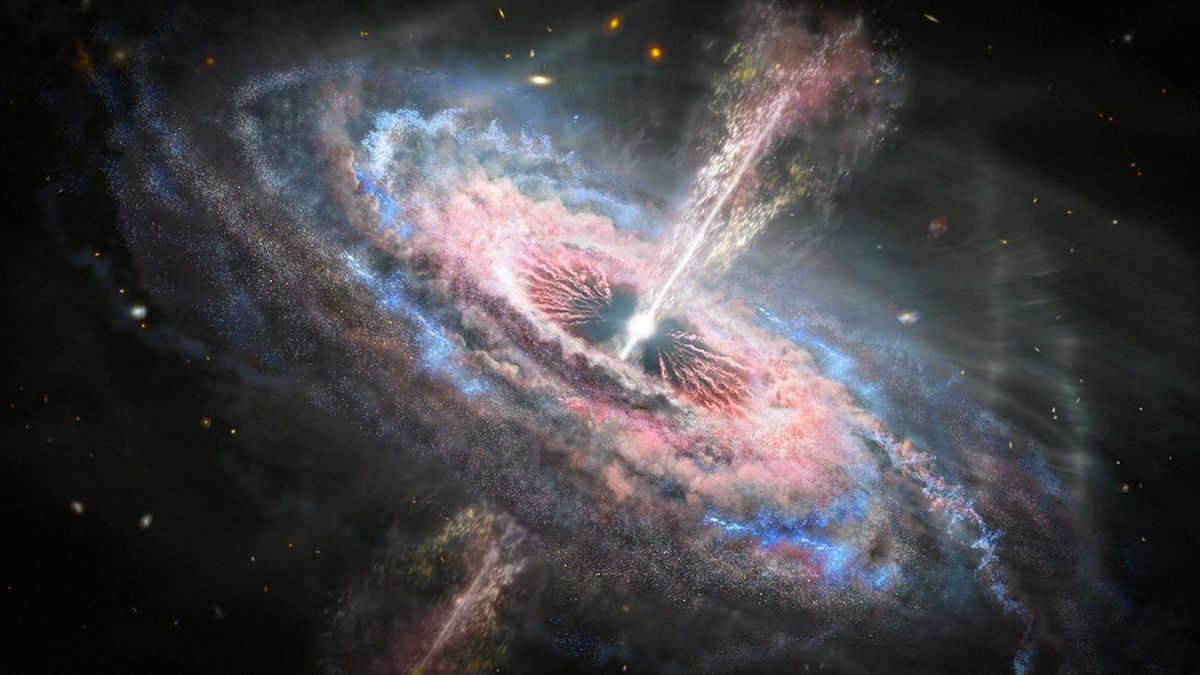
Most massive stars eventually transform into black holes, although not all of them exist in binary systems or exhibit streaming behavior. In such cases, alternative methods are used to search for black holes. Sergey explains that a black hole profoundly distorts the fabric of space-time surrounding it, with compactness being the key factor rather than sheer mass. It’s easy to comprehend if you visualize a sharp object—a small object with a concentrated mass. If you were to lightly tap it with your finger, you wouldn’t penetrate its surface. However, if you were to exert the same force with a needle, it would pierce through. Therefore, objects with smaller sizes but equal mass produce a more pronounced curvature of space-time. This phenomenon is known as gravitational lensing.

Researchers are able to witness a star and suddenly detect a symmetrical fluctuation in its luminosity. Although no direct impact occurred on the star, a colossal entity passed between it and us. This immense object, causing a distortion in the fabric of space and time, gathered the incoming rays of light.
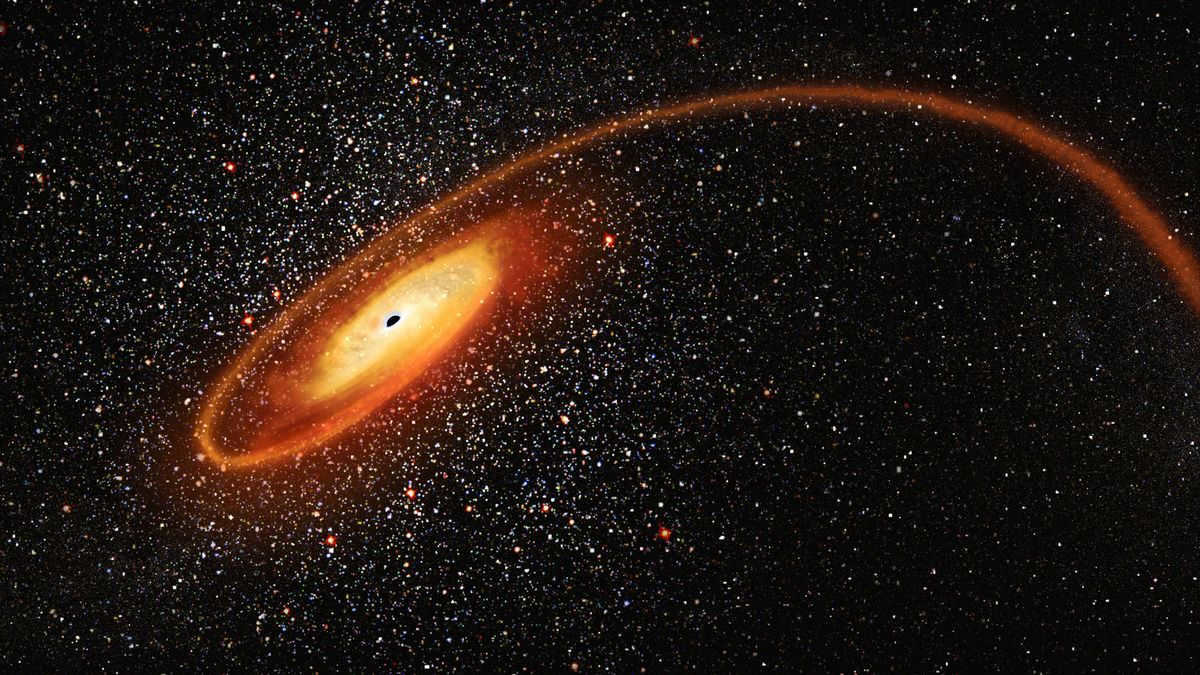
It seems that the brightness of the star is increasing, but in reality, more of its light has been captured and reached us. A star weighing ten times that of the sun would shine quite noticeably, making it impossible for scientists to overlook it. And in these observations, a completely dark entity with a mass equivalent to about ten solar masses emerges. What could it possibly be? Only a black hole.
If there happens to be a pair of black holes, their merger would produce a burst of gravitational waves. And in 2015, these gravitational wave bursts were successfully detected for the first time. This is currently the most effective method available for identifying black holes.
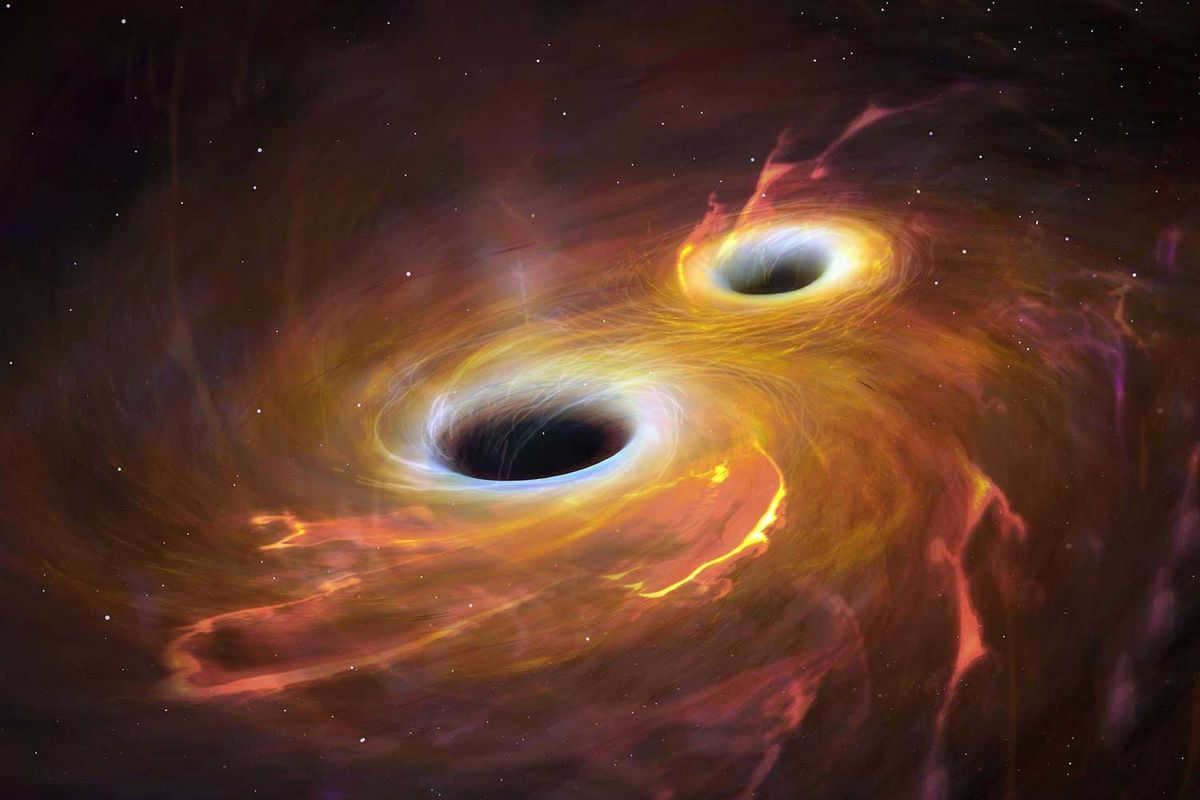
Photographing a black hole: a unique challenge
A technique for capturing an image of a black hole involves taking inspiration from the concept of the invisible man depicted in movies and books. Just like the invisible man can be detected through the clothes he wears, black holes can be indirectly observed through the behavior of the matter that surrounds them. Scientists are unable to directly observe the event horizon or the interior of a black hole due to the impossibility of anything crossing the horizon back towards us. However, by analyzing the interactions and effects caused by the black hole on its surroundings, valuable insights can be gained.
The image that is commonly known as a photograph of a black hole actually depicts the movement of matter around the black hole. However, in the center, there exists a dark area due to the presence of a black hole that emits no light.
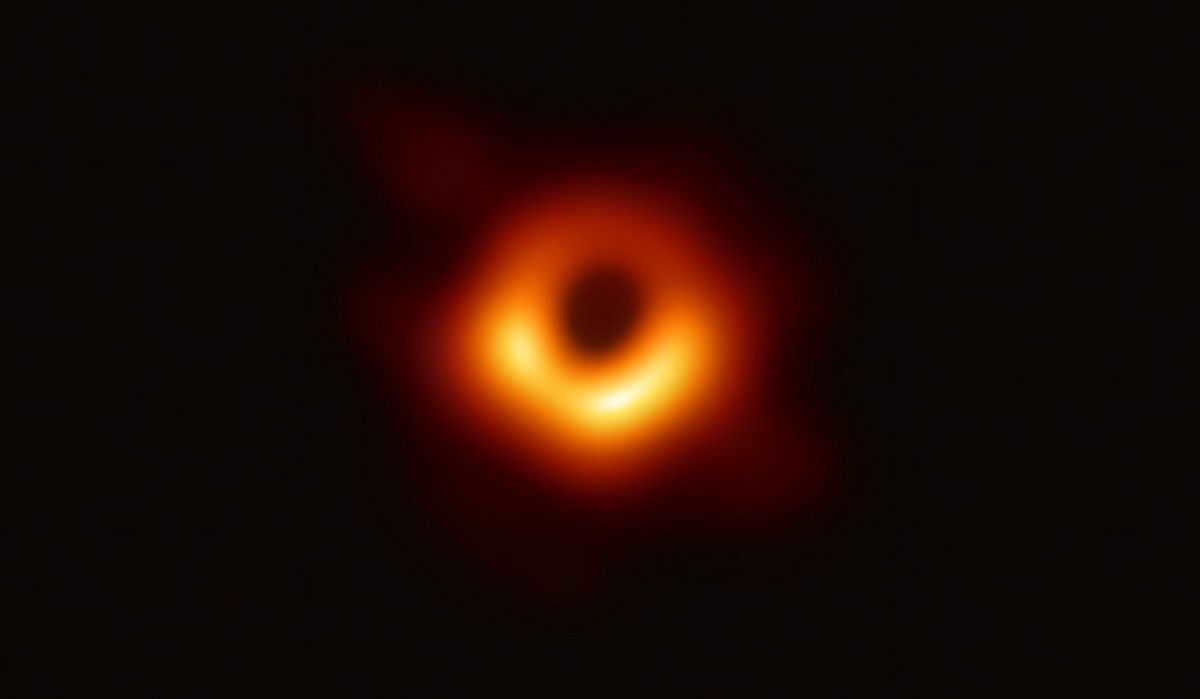
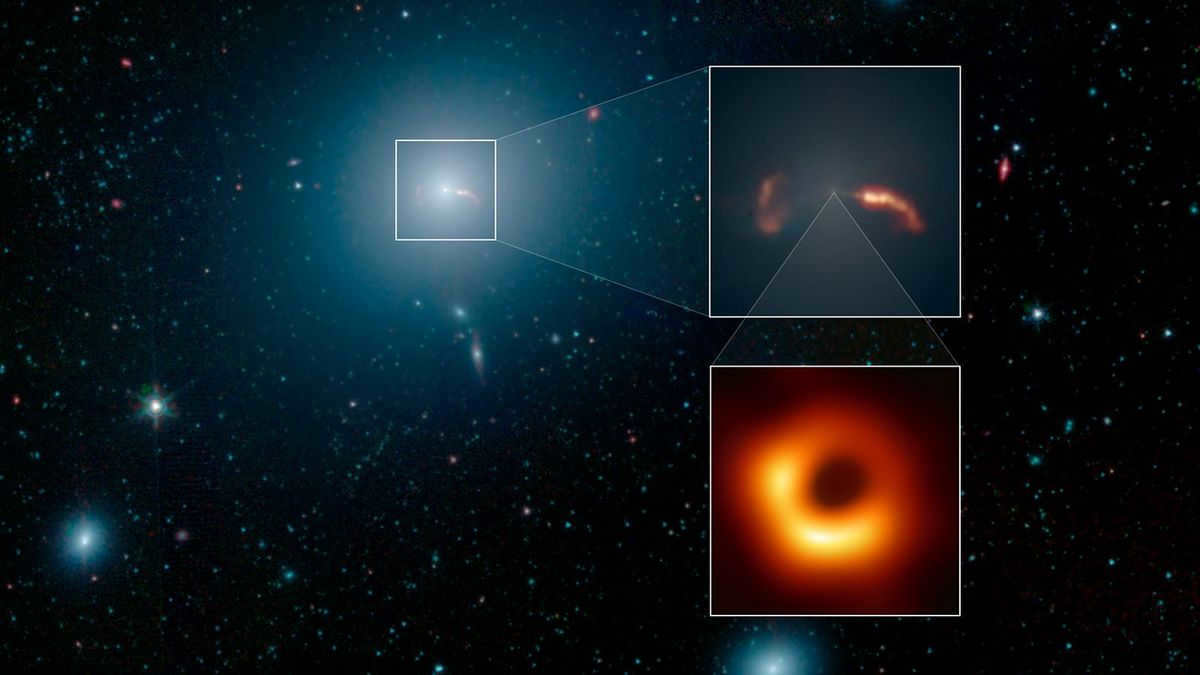
In order to obtain an image of objects similar to a picture, scientists require innovative tools. Nonetheless, there exists tangible direct proof of the conduct of matter surrounding various black holes, extending nearly to the brink. These distances are only a few multiples of the magnitude of the black hole’s horizon.
This celestial body is located within a stellar system that is visible in the nocturnal firmament without the aid of optical aids; however, astronomers were previously unaware of its concealed presence.
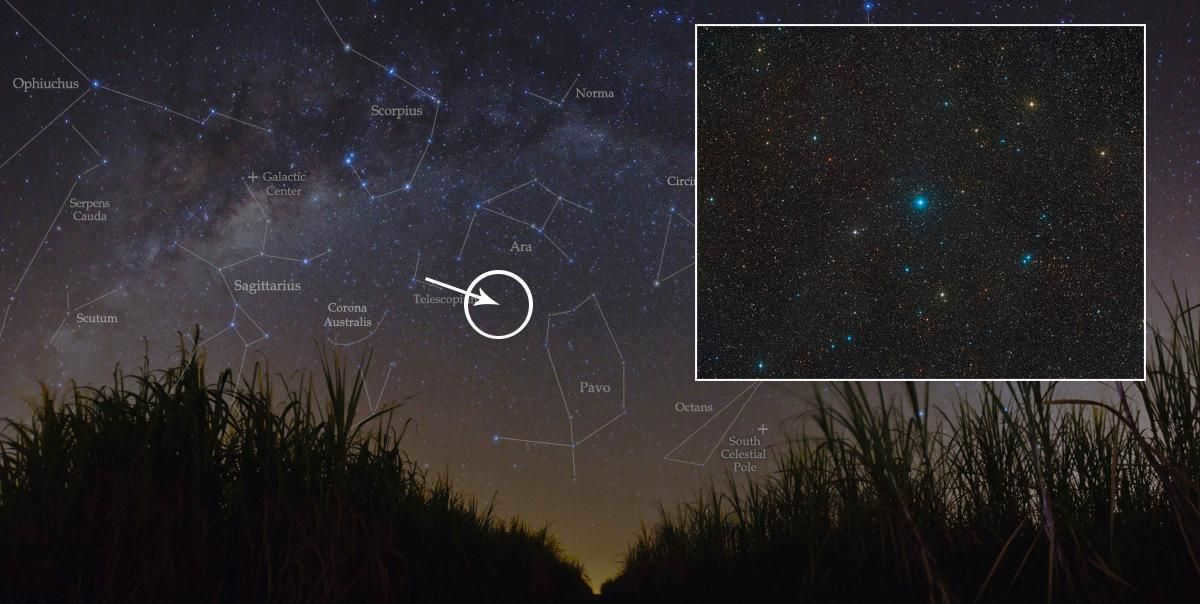
Located in the constellation of Telescope, the star system that contains the closest black hole to Earth has recently been thoroughly studied by astronomers using a telescope installed at the “La Silla” observatory in Chile. Surprisingly, it has been discovered that this system is not a binary star, but rather a triple star system, with an invisible object of approximately four times the mass of the Sun, which exerts gravitational influence on its companions. Observations have revealed that one of the stars is in close proximity to this invisible object, as they orbit around a common center of mass, completing a full revolution every forty days. On the other hand, the second star is much farther away.
We were absolutely astonished to find out that this star system is the first one with a visible black hole that can be seen without any magnification
one of the researchers involved in the investigation
Cosmos
Scientists have irrefutably demonstrated the potential existence of alien life
Presence of a river on Mars provides evidence of past precipitation on the planet
Baby images of celestial bodies. Researchers demonstrate the birth of new planets in outer space
Astrophysicists have observed that the black hole is able to effectively remain concealed from observers due to its lack of interaction with the surrounding environment – its presence is only detectable through the immense gravitational force it exerts. It is now believed that there are many such invisible entities scattered throughout the cosmos, yet we remain unaware of their existence. At present, only a handful of black holes have been identified by the scientific community. Meanwhile, over the course of the Milky Way galaxy’s 13 billion years of existence, countless millions of stars would have ended their lifecycle by collapsing into black holes. Not all of these black holes, however, would have a companion star that would enable their detection.
On May 12, 2022, a significant event occurred in the field of science: the project “Event Horizon Telescope” (EHT) unveiled the highly anticipated image of Sagittarius A* – a radio source located at the center of the Milky Way. This day marked a major milestone in scientific history, with press conferences taking place simultaneously worldwide to announce this groundbreaking discovery.
For years, astronomers have speculated that Sagittarius A* is a supermassive black hole. However, a small percentage of doubt regarding its true nature remained in scientific discussions. There was always a possibility that it could be something else entirely. But with the release of the EHT image, all doubts were finally put to rest. It is now confirmed that Sagittarius A* is indeed a black hole.
Now, let’s delve into the process of capturing this historic image, its significance, and the reasons behind the long-awaited reveal.
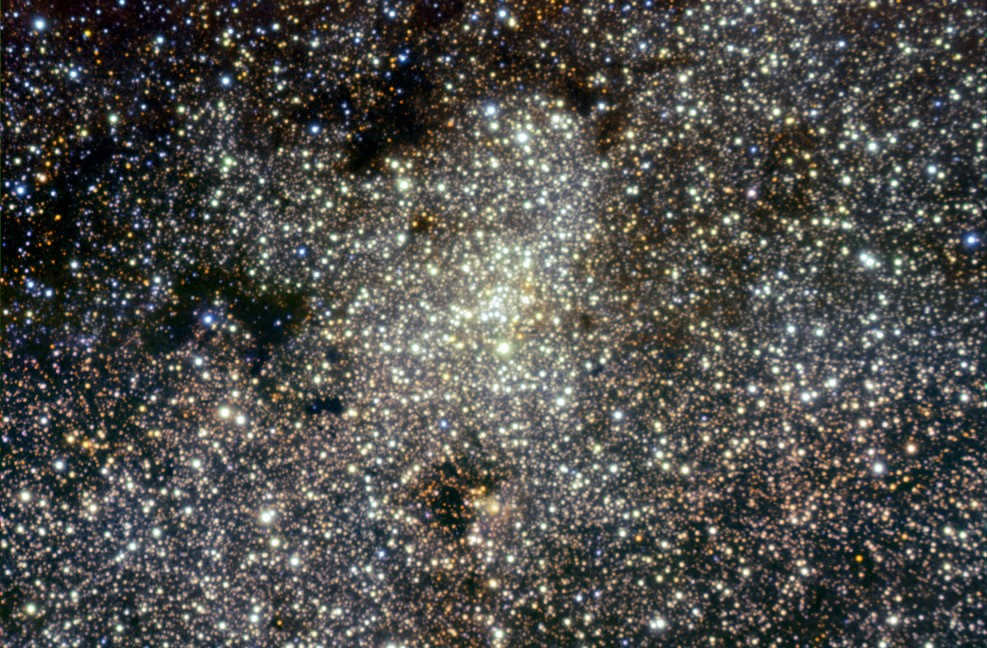
An enigma spanning nearly a century
During the 1930s, early pioneers in the field of radio astronomy made a curious discovery – an unexplained interference originating from somewhere in the vast expanse of the sky. As time went on, it became increasingly clear that the source of this perplexing signal was not to be found on Earth or even within our own solar system, but rather in the central regions of our very own galaxy.
Regrettably, the heart of the Milky Way is shrouded by dense clouds of dust that absorb all visible light. Consequently, astronomers were left without a means to peer into this cosmic region using traditional telescopes in order to uncover the true origin of these enigmatic radio signals. The outbreak of the Second World War soon after diverted the attention of scientists, causing them to set aside the mystery of celestial interference for many years.
Following the war, there was a significant expansion in the field of radio astronomy. Innovations in technology led to the construction of advanced radio telescopes, enabling astronomers to conduct comprehensive research on the Milky Way. In the 1970s, scientists made a groundbreaking discovery: a compact radio source emitting interference from the central region of our galaxy. This remarkable finding was designated as Sagittarius A*.
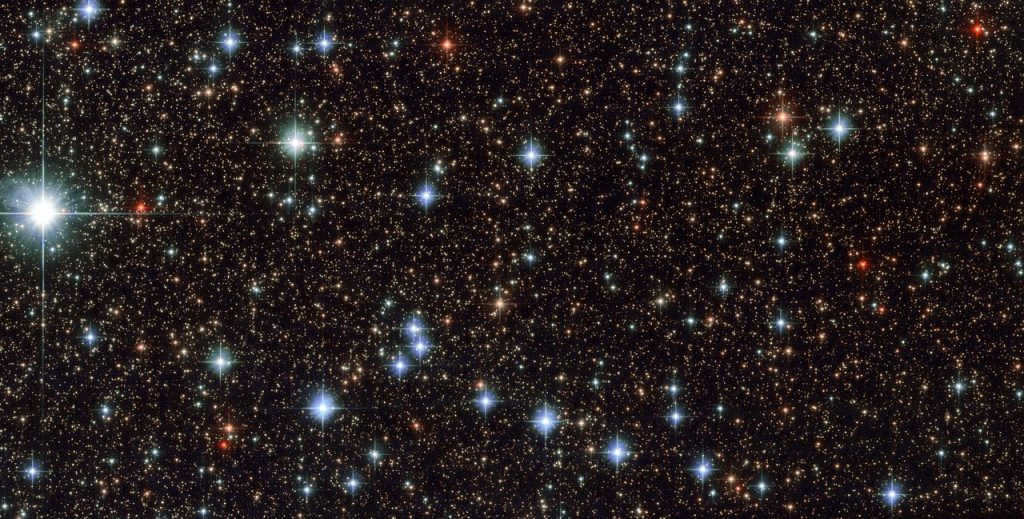
Sagittarius constellation, Hubble telescope photo
During the same period, the first infrared observations were conducted to study the center of the Milky Way. Unlike visible light, infrared radiation is able to penetrate through dust clusters, allowing researchers to identify various structures at the core of our galaxy. These structures included stars and gas clouds that were found to be orbiting around Sagittarius A*.
Further analysis of the orbits of these objects revealed that Sagittarius A* possesses a mass millions of times greater than that of our Sun. This led astronomers to conclude that the only object with such characteristics could be a supermassive black hole.
A black hole is a region in space-time that exerts an incredibly powerful gravitational force, preventing both particles and electromagnetic radiation from escaping. The boundary of this region, known as the event horizon, marks the point of no return.
The Structure of a Black Hole
From a non-expert’s perspective, a black hole can be described as a celestial “vacuum cleaner” that attracts and absorbs anything that comes near it. Black holes are capable of consuming matter and even tearing apart entire stars. However, it is important to note that there are various types of black holes, including stellar-mass black holes. These black holes are formed when massive stars undergo gravitational collapse. These objects, which typically have a diameter of a few tens of kilometers, have an average mass ranging from 5 to 50 times that of our sun.
However, the supermassive black hole at the heart of our galaxy, the Milky Way, is quite different. Recent calculations have revealed that it possesses a mass of 4.2 million times that of the Sun and spans a diameter of 26 million kilometers. These extraordinary celestial bodies are referred to as supermassive black holes. It is now widely accepted that these colossal entities exist at the centers of most galaxies. Furthermore, their significance extends far beyond that of mere “vacuum cleaners”.
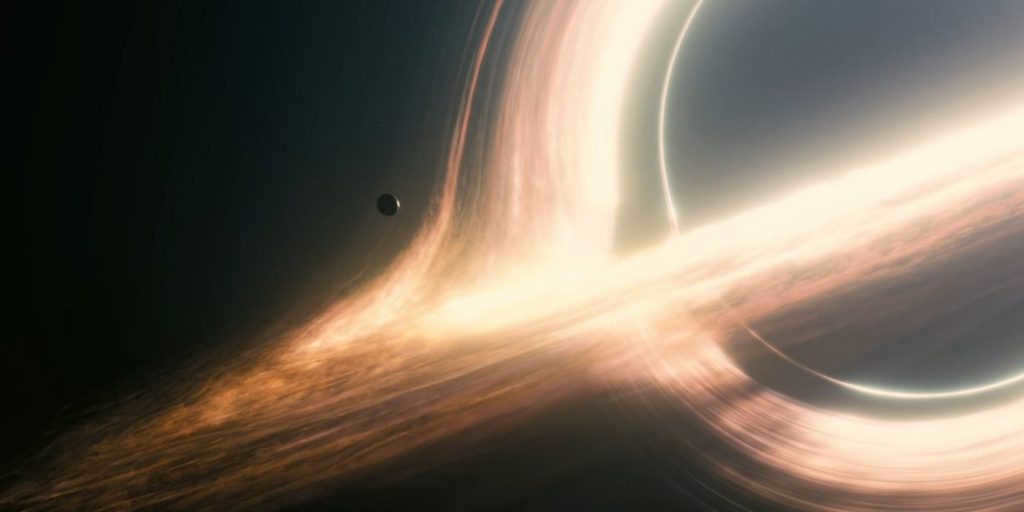
The film “Interstellar” portrays a black hole that was visualized based on calculations made by astrophysicists.
Supermassive black holes have a significant impact on their galaxies. They can actively suppress star formation processes and even destroy entire star clusters. However, in certain circumstances, black holes can also play a role in the creation of new stars. Astronomers have observed cases where the influence of black holes has actually contributed to the formation of new stars. All of these processes play a crucial role in the evolution of galaxies, which in turn can greatly impact the potential for life to originate within them.
What occurs if one were to leap into a black hole?
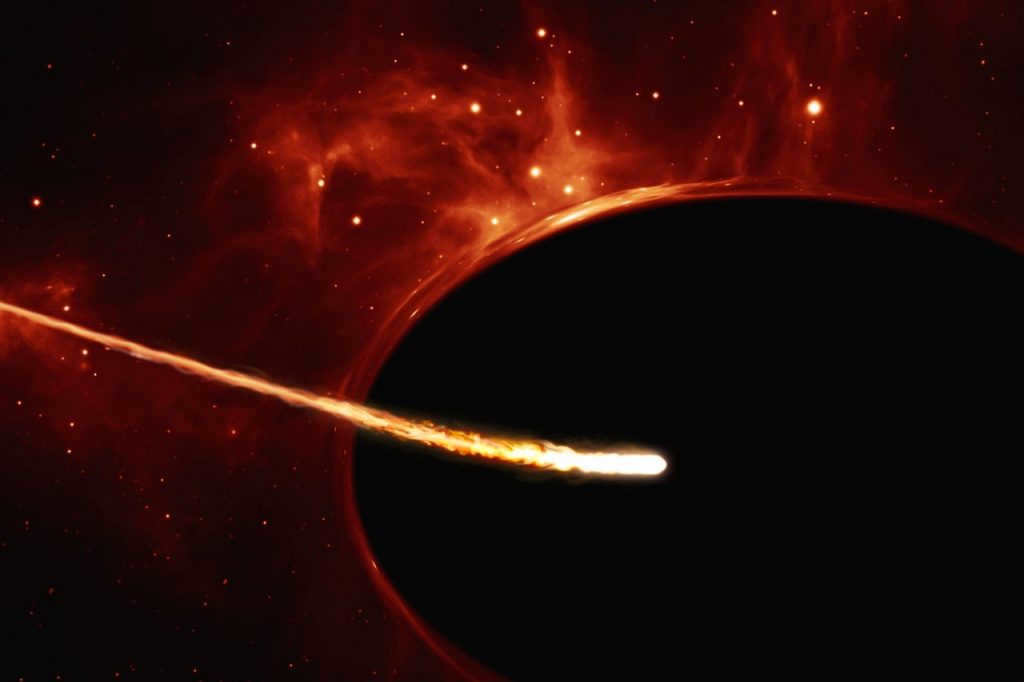
The descent of a celestial body into the gravitational pull of a singularity (as portrayed by an illustrator)
Any discussion concerning singularity is incomplete without debates regarding the fate of the intrepid explorer who dares to venture into its depths (let us set aside the question “why?” for now). Is it conceivable to traverse the event horizon, akin to the portrayal in the film Interstellar, and avoid the transformation into elongated pasta?
The outcome, in this case, hinges upon the mass of the singularity. Plunging into a singularity of stellar proportions is unfeasible, as the diminutive size of such an entity would subject the vessel and its ill-fated occupant to insurmountable tidal forces. However, as the mass of the singularity increases, the likelihood of a more favorable outcome also increases (though a woeful fate still awaits the explorer).
Black holes have the ability to engulf anything that crosses their event horizon. Their gravitational force is so incredibly strong that even light is unable to break free. This means that the singularity itself is actually impossible to visually observe. This leads us to wonder: if black holes are invisible, then where does the radio emission detected from Sagittarius A* originate? And furthermore, what exactly is depicted in the recent image that was captured?
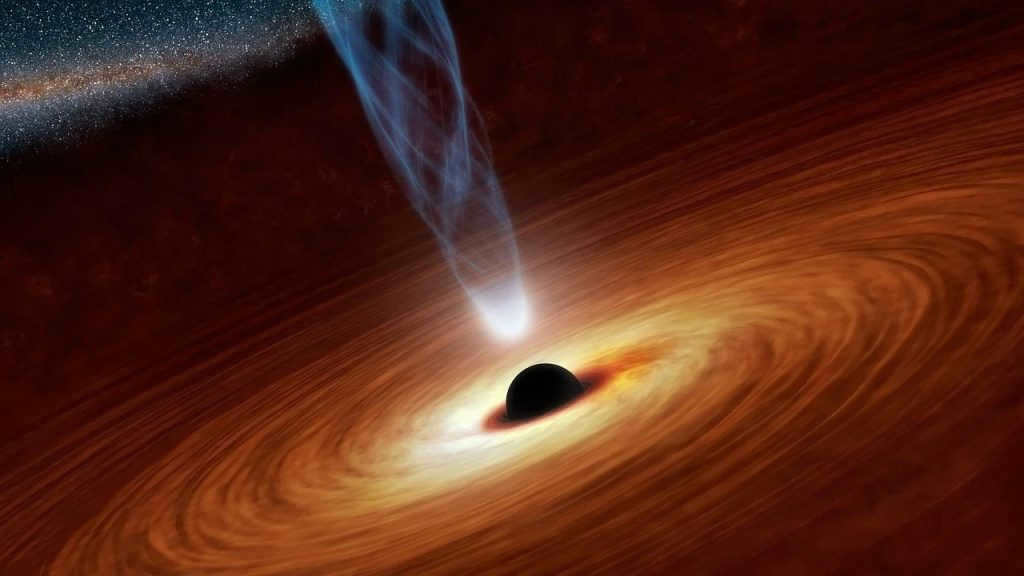
Black hole with an accretion disk and jets (as depicted by an artist)
Indeed, black holes themselves do not emit any radiation (although they may emit Hawking radiation, but we’ll save those details for another time). However, the absorption of matter is not instantaneous. The matter that is captured by the black hole begins to orbit around it, forming an accretion disk. Within this disk, particles of matter constantly collide with each other, resulting in intense heating. This heating process generates radiation across various ranges of the electromagnetic spectrum, thus revealing the presence of the black hole.
Therefore, even though the actual black hole is invisible to the naked eye, we are able to observe its “shadow” – a dim outline within the bright accretion disk that mirrors the shape of the black hole and its surroundings. Consequently, if this silhouette is visible, it can also be captured in a photograph.
Further information about this subject
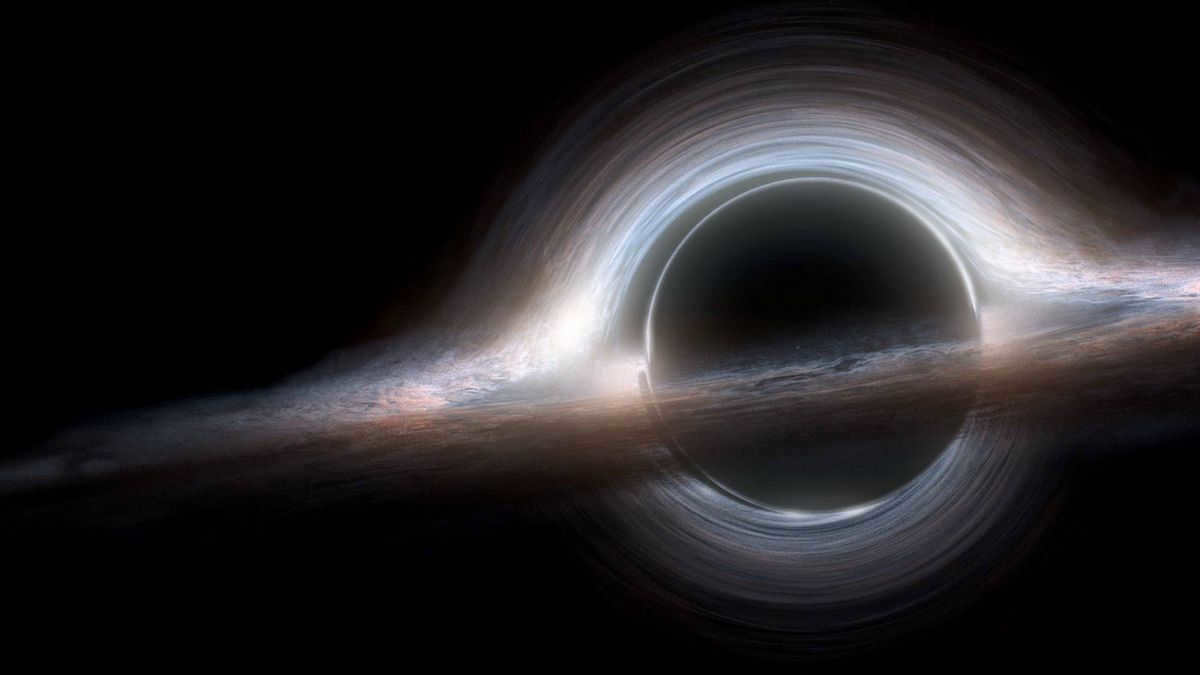
The core of black holes: singularity, event horizon, spaghettification
There exist numerous astonishing rumors, legends, and theories regarding black holes. It’s no surprise since we are unable to directly observe and verify our assumptions about them – the laws of nature forbid it.
Astronomers from all over the world have long had a desire to capture an image of the outline of a black hole. The issue is that none of the existing optical telescopes possess the necessary resolution to achieve this goal. However, scientists have found a solution – they are creating a virtual radio telescope that is the size of the Earth.
The concept behind this idea is that the same object is observed simultaneously by multiple radio observatories. The data from each observatory, along with the precise time of observation (which is determined using atomic clocks), is then combined and processed using special algorithms. This process allows for the creation of a virtual version of the telescope, with dimensions equal to the maximum distance between the original telescopes.
The “Event Horizon Telescope” project was founded on this concept, gathering over 300 scientists from sixty scientific institutions worldwide. The primary objective was to capture an image of the silhouette of a black hole, with eight observatories across four continents assigned to the task.
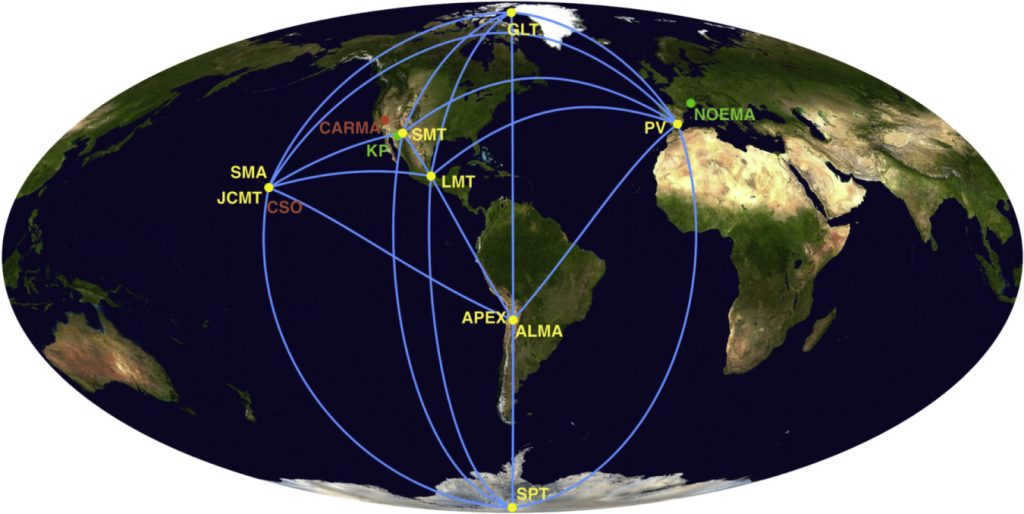

The facilities of the Event Horizon Telescope are located at:
In 2017, the EHT conducted groundbreaking observations, accumulating a total of 4 petabytes of data. Due to the immense size of this data, it couldn’t be transmitted over the Internet and had to be physically transported using hard disks.
Aside from capturing Sagittarius A*, the EHT also successfully imaged the center of the M87 galaxy in 2017. This galaxy is home to an incredibly massive black hole, weighing in at 6.5 billion times the mass of our Sun (not a million!). The publication of the image of its shadow in 2019 was one of the year’s most significant scientific achievements.
One of the factors that contributed to the delayed release of black hole images was the vast distances separating the EHT observatories. To illustrate, in April 2017, the SPT radio telescope, situated at the South Pole, carried out observations. However, due to the remote location, it was not until December that the collected data could be transported to the Big Earth via airplane.
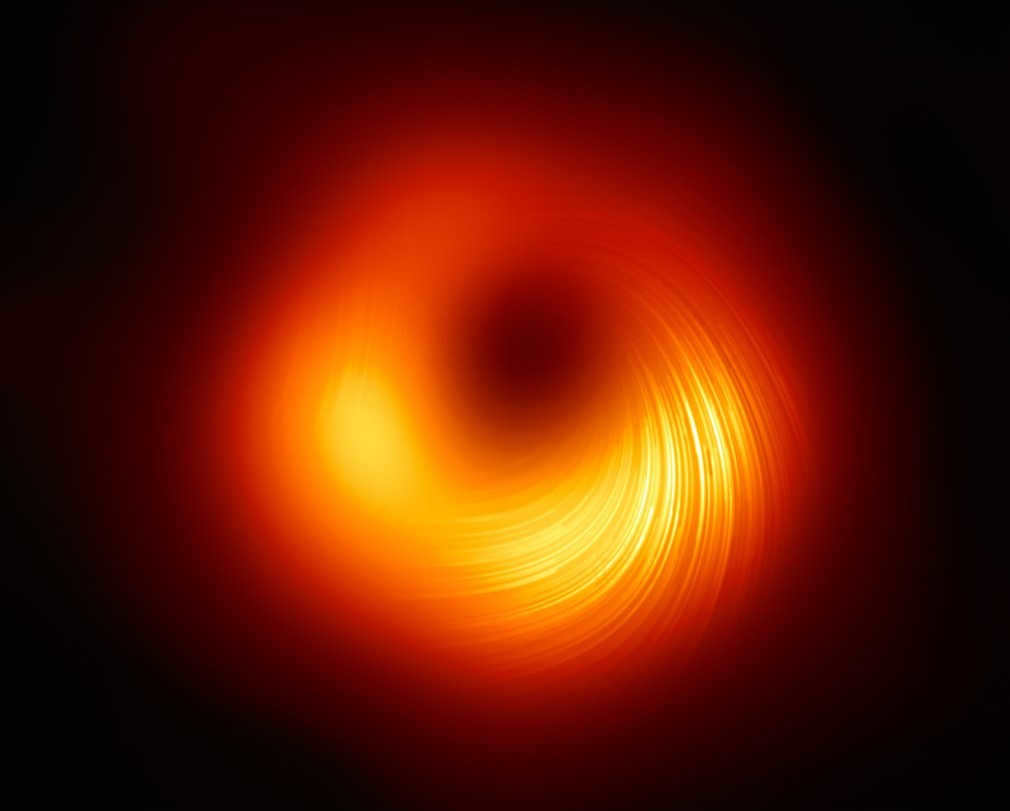
Why did we witness an image of faraway M87 three years prior to an image of Sagittarius A*, which is practically in our backyard? Despite having similar apparent sizes in the sky, M87 is 1600 times larger than Sagittarius A*, but the latter is nearly 2000 times closer to us.
It all comes down to the size of the black holes themselves. Measurements indicate that the gas surrounding both gravitational monsters moves at nearly the same velocity, which is almost equivalent to the speed of light. However, when it comes to orbiting a much larger black hole at the center of the M87 galaxy (which has an event horizon radius of 18 billion kilometers, three times the distance between the Sun and Pluto), it takes anywhere from a few days to a few weeks. The project participants claim that the images captured at weekly intervals were practically indistinguishable. This made the task of processing and merging them into a single “portrait” much easier.
The black hole in the center of our galaxy, known as Sagittarius A*, presents a unique challenge due to its small size and the rapid movement of gas around it. In just a matter of minutes, the gas completes one revolution, causing fluctuations in the brightness and structure of the black hole’s accretion disk. This variability posed a significant obstacle in creating a cohesive image.
To overcome this obstacle, researchers captured thousands of images of Sagittarius A* and developed sophisticated algorithms and programs to model the gas’s motion. By averaging the images from multiple visualizations, they were able to create a composite image of the black hole. This process required immense computational power and a considerable amount of time. However, on May 12, humanity was finally able to witness the first-ever glimpse of the shadow cast by the black hole lurking in the heart of our galaxy.
Photo of the century
Even though the black holes of Sagittarius A* and M87 are vastly different in size, the image of Sagittarius A*’s shadow is remarkably similar to that of M87. We can observe a bright ring of gas encircling a region from which even light cannot break free. This discovery is highly significant for Einstein’s theory of general relativity, as the size of the ring captured by the Event Horizon Telescope aligns precisely with its predictions.
There are three distinct regions visible within the ring itself. The project participants have observed similar formations in all of the Sagittarius A* images, although each time they appeared in a different section of the disk. It is probable that these formations are the result of artifacts produced by the interferometry technique employed by the scientists to create the image. Additionally, the computer-generated reconstruction revealed a high likelihood that the black hole situated at the core of our galaxy is rotating in a counterclockwise direction, with its axis approximately aligned towards Earth.
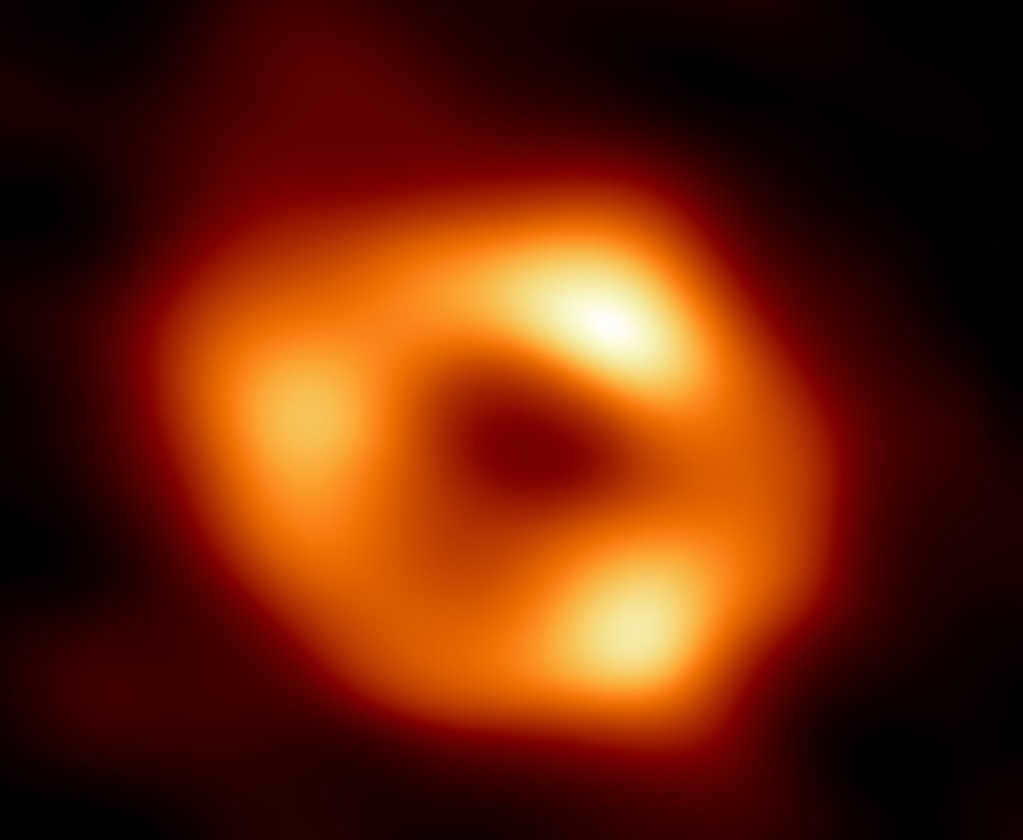
At the heart of our galaxy lies a massive bagel, serving as its center.
The image of Sagittarius A* provided further evidence supporting the principles of General Relativity. Once again, Einstein’s longstanding theory has proven its validity through practical experimentation. Now, scientists can confidently assert the existence of a black hole at the center of our galaxy, without any need for qualifying words such as “probably” or “most likely.”
In addition, astronomers currently have access to images of two black holes that exhibit significant differences in terms of their size and level of activity. While the massive black hole located at the center of M87 emits enormous jets, our local black hole, Sagittarius A*, remains relatively inactive. This contrast allows astrophysicists to conduct comparisons and utilize them to validate their theories and models. It is also worth mentioning the existence of extraordinary astronomical conjectures such as Einstein-Rosen bridges or white holes. Theoretically, the EHT may eventually have the capability to observe such phenomena, assuming they do indeed exist.





